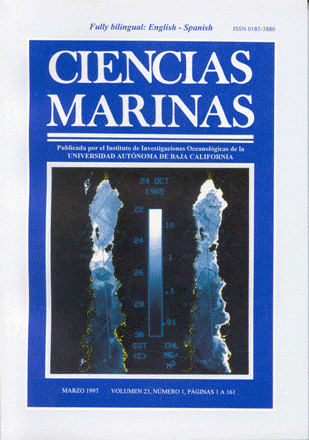Daily zooplankton grazing rates off the coast of baja california
Main Article Content
Abstract
Durante el verano de 1990, se generó una serie de tiempo de 15 días (14 al 28 de julio) de tasas diarias de pastoreo, por el método del cambio en la concentración de clorofila a, para la fracción del macrozooplancton (>200 um) en una estación en la costa de Baja California, México. La columna de agua presentó condiciones hidrográficas estables. Los copépodos y eufáusidos fueron las poblaciones más abundantes dentro del zooplancton. En general, las tasas de pastoreo (0 a 2.5 d-1) y filtración (0 a 8.8 ml erg-1 d-1) fueron del mismo orden de magnitud que las reportadas previamente. El macrozooplancton consumió alrededor del 25% del titoplancton disponible. Las tasas de filtración y pastoreo presentaron una gran variabilidad de día a día (mayor que l00%). Es, por tanto, recomendable la realización de series de tiempo de al menos 7 a 10 días, para tener una mejor comprensión de la presión de los consumidores sobre las poblaciones del fitoplancton.
During the summer of 1990, a 15-day (14 to 28 July) time series was generated to measure the daily grazing rates of macrozooplankton (>200 um), studying the changes in the chlorophyll a concentration at a station on the coast of Baja California, Mexico. The water column showed stable hydrographic conditions. Copepods and euphasiids were the most abundant organisms within the macrozooplankton populations. In general, grazing (0 to 2.5 d-|00E2|??) and filtration (0 to 8.8 ml erg-1 d-1) rates were of the same order of magnitude as values previously reported. Overall phytoplankton consumption by the macrozooplankton was about 25%. Grazing and filtration rates showed great variability from day to day (greater than l00%). It would, therefore, be advisable to generate time series studies of at least 7 to 10 days, in order to arrive at a better understanding of the zooplankton pressure on the phytoplankton populations.
During the summer of 1990, a 15-day (14 to 28 July) time series was generated to measure the daily grazing rates of macrozooplankton (>200 um), studying the changes in the chlorophyll a concentration at a station on the coast of Baja California, Mexico. The water column showed stable hydrographic conditions. Copepods and euphasiids were the most abundant organisms within the macrozooplankton populations. In general, grazing (0 to 2.5 d-|00E2|??) and filtration (0 to 8.8 ml erg-1 d-1) rates were of the same order of magnitude as values previously reported. Overall phytoplankton consumption by the macrozooplankton was about 25%. Grazing and filtration rates showed great variability from day to day (greater than l00%). It would, therefore, be advisable to generate time series studies of at least 7 to 10 days, in order to arrive at a better understanding of the zooplankton pressure on the phytoplankton populations.
Downloads
Download data is not yet available.
Article Details
How to Cite
Lara-Lara, J., & Matus-Hernandez, M. (1997). Daily zooplankton grazing rates off the coast of baja california. Ciencias Marinas, 23(1), 71–81. https://doi.org/10.7773/cm.v23i1.778
Issue
Section
Research Article
This is an open access article distributed under a Creative Commons Attribution 4.0 License, which allows you to share and adapt the work, as long as you give appropriate credit to the original author(s) and the source, provide a link to the Creative Commons license, and indicate if changes were made. Figures, tables and other elements in the article are included in the article’s CC BY 4.0 license, unless otherwise indicated. The journal title is protected by copyrights and not subject to this license. Full license deed can be viewed here.

